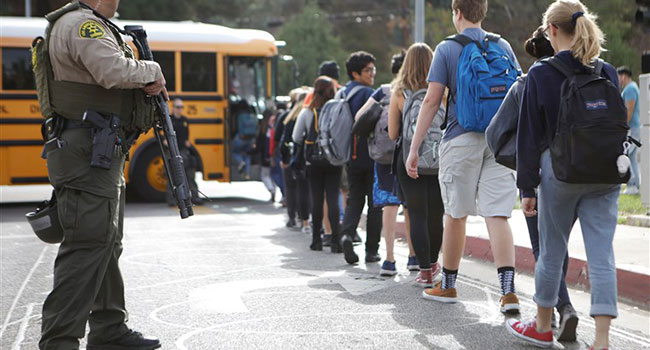
Seven Steps to Effective Emergency Communication and Response
- By Magen McGahee
- February 01, 2022
The tragic school shooting in Oxford Township, Michigan, that left four teenagers dead and seven other people injured—including a teacher—has put the threat of school violence once again at the top of every K–12 leader’s mind.
While the Michigan shooting was the deadliest of the 2021–22 school year to date, it wasn’t the first such occurrence this year, which has seen a rise in school violence coinciding with a return to in-person instruction during the pandemic. Unfortunately, these events serve as a stark reminder of the need for every school to have a sound crisis response and communications plan.
The Michigan shooting was part of a troubling upswing in school violence that experts attribute, in part, to the psychological toll the pandemic has inflicted on young people. U.S. News reports that between Aug. 1 and Nov. 3, 2021, there were 123 incidents of gunfire on school property in the United States. During the same three-month period in 2019, the Center for Homeland Defense and Security’s K–12 School Shooting Database recorded only 40 such incidents.
Having to attend school remotely, not being able to meet up with friends, and other pandemic-related incidents have all contributed to the stress that many students are feeling. In some cases, this emotional trauma spills over into violence.
In May 2021, the Department of Homeland Security issued a public awareness bulletin that noted, “The threat of targeted violence in schools will remain elevated as more children return to school full-time.” The bulletin warned of the impacts of social isolation brought on by remote schooling, with 30 percent of youth ages 13–19 reporting that they feel unhappy or depressed and 29 percent saying they don’t feel connected to adults at school. These conditions are potential risk factors for an eruption of violence at school, DHS said.
Maintaining a safe school environment begins with establishing a culture of caring, in which every student feels seen and valued. K–12 leaders must ensure that every child has a positive relationship with at least one adult they can trust and that students understand the need to treat each other with kindness and respect.
Adults in the building should also recognize the warning signs of students who might be at risk of violent behavior and should know how to follow up as appropriate. Students should be encouraged to report their concerns, and there should be some mechanism for them to do so safely and discretely, such as an anonymous hotline. Take all threats and concerns seriously, and do your due diligence in investigating them.
Despite the best efforts of K–12 leaders, violence can occur at any time and in any school setting. An effective crisis response and communications plan can mitigate the threat of injury or death during such an occurrence.
Here are seven essential steps for developing an effective emergency communication plan.
#1: Be prepared.
Create a system for quickly alerting building occupants during an emergency, as well as a strategy for managing external communications with parents and other stakeholders. Produce easy-to-use communication templates in advance, so you don’t have to draft messages on the fly when a crisis occurs.
#2: Know your roles.
Your plan should outline who can activate an emergency alert and under what circumstances. It should also define who’s responsible for which tasks. Assemble a crisis response and communications team and designate who’s responsible for collecting information, monitoring the situation, and providing updates to stakeholders, so that you’re communicating with a single, unified voice during an emergency.
Practice your response a few times a year so that everyone knows their roles. Also, assign backups for these functions in case the main person for each role is incapacitated.
#3: Identify key stakeholders.
Know who to contact in advance. Keep all contact information up to date, and identify everyone’s preferred method of communication if possible. With all of the other priorities that K–12 leaders have today, proactively collecting this information can be challenging; however, having current contact information is critical in an emergency.
#4: Use multiple methods of communicating.
Using a variety of ways to reach stakeholders during an emergency increases the likelihood that they’ll see your messages. An automated communications system can send notifications via text message, email, intercom, visual alerts, and other means instantly at the push of a button.
#5: Provide frequent updates.
An emergency situation is highly fluid, and circumstances can change rapidly. Getting up-to-the-minute information to the building’s occupants can help save lives. Make sure you communicate frequent updates as the situation evolves and new information becomes available.
#6: Keep emergency first responders in the loop.
Notifying law enforcement and other first responders instantly when an emergency arises—and continuing to provide quick, accurate information as the situation develops—can make a huge difference in an event where every second matters. Tying first responders into your emergency communications system can keep them apprised of the situation in real-time so that they can respond quickly and effectively.
#7: Integrate communication with other security measures.
To improve safety even further, consider supplementing your emergency alert system with other security measures such as remote door locks. With remote locking, administrators who have the right credentials can lock any door in the building with the touch of a button from their personal device of choice—helping to keep students out of harm’s way.
In an emergency, every second counts.
Timely and effective communication is critical during an emergency. Rapidly assessing the situation and getting stakeholders the information that they need to respond quickly and effectively can mean the difference between life and death—and these seven steps can help.
This article originally appeared in the January / February 2022 issue of Campus Security Today.